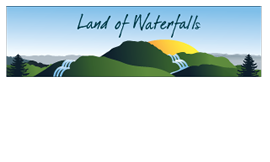The
development of roads has always played a vital role in the growth of any
region. Native Americans, early
explorers, trappers, traders and settlers, those escaping the summer heat of
lower elevations and the first industrialists all helped in various ways to
build the road system Transylvania County has today.
The
earliest paths were created by the buffalo, elk, deer and smaller game animals
that made their homes in the mountains and valleys and along the rivers and
streams. Native Americans followed these
same routes to hunt game, gather berries and nuts, and travel between villages. As the first white men
came into this area they widened and improved these paths into riding trails
and wagon roads.
By the
late 1700s and early 1800s when the settlers were moving into the area the
militia was used to construct roads. In
1790 the Buncombe County Court ordered the
local Militia Company to build a “wagon road” following near the Estatoe Path
from the Swannanoa River to the Davidson River. Two years later
in 1792 Clayton’s Militia was ordered to join it with the Catawba Trail near
Flat Rock through the Little River and Crab Creek valleys. In
April 1793 James Davidson, Moses Smith and Walter Hogshead were ordered to
serve on a road jury to layout a road from the Estatoe Ford of Ben Davidson’s
River to the middle fork of the French Broad River.
As the
population of the state grew so did the demand for roads. By the mid 1800s the North Carolina General
Assembly held authority for the laying out of roads. For example in 1854 they authorized the
laying out and making of a turnpike road from the South Carolina line at or
near the Sassafras Gap through the valleys of the East Fork and French Broad Rivers to any
point on the French Broad Turnpike Company’s Road.
During the Civil
War road improvements in North Carolina ceased and the roads fell into
disrepair. Following the Civil War the common means of road construction,
improvement or repair was to require road duty from citizens. Men were commissioned to work on the roads
annually. Each man must provide his own
tools. There were fines imposed on
anyone who failed to appear or did not have tools. The age requirement, service time and fines
seemed to vary by county.
In September 1911 Transylvania County
Commissioners voted to begin using convict labor for road work. Previously local convicts had been hired out
to Buncombe and Henderson counties. By
late 1912 convict labor was being used and the days of mandatory road duty
ended.
The photograph seen here shows a work crew
with convicts cutting a road along a Transylvania County mountainside in
1931. Ed Comer has hiked along today’s
Hwy 276 as well as the old Mill Hill Turnpike between Island Ford Rd. and
Connestee Rd. in an effort to identify the location of this photograph. Visit the NC Room Blog at
nchistoryroom.blogspot.com for a current photograph of the area believed to be
shown in the old picture and a topographic map marking the area.
Photographs
and information for this column are provided by the Rowell Bosse North Carolina
Room, Transylvania County Library. Visit
the NC Room during regular library hours (Monday-Friday) to learn more about
our history and see additional photographs.
For more information, comments or suggestions contact Marcy at [email protected]
or 828-884-3151 X242.
 |
| Transylvania County “chain gang” road construction, 1931. |



